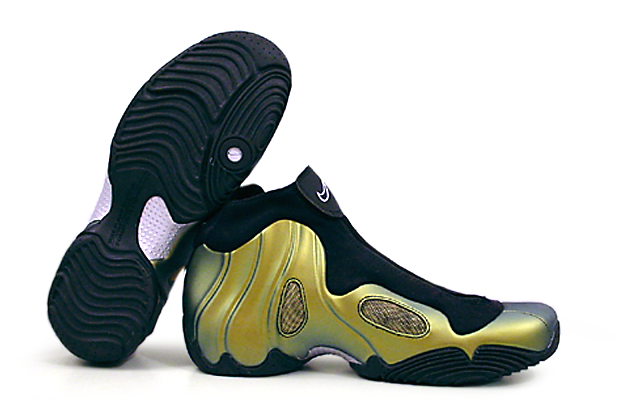Released in early 1999, the Air Flightposite was the second iteration of Nike’s Foamposite technology. A year later, it still represents the state of the art in sneaker design, materials and engineering.
[Prof’s Note: What better way to revive Ko than with the shoe that started it all: the Nike Air Flightposite, which I originally reviewed on August 15th of 2000. And this is timely to boot, with the beautiful “Copper” colorway of the Flightposite Premium set to drop this Saturday, September 27th; see pics of the Copper at NiceKicks.com.]
The Nike Air Flightposite was one of the most controversial shoes in Nike’s long line of controversial shoes. Released in 1999 the shoe was Nike’s second generation implementation of Foamposite technology.
There’s no such thing as middle ground when it comes to opinions on the Flightposite: people either absolutely love it or absolutely hate it. Time Magazine went so far as to pronounce the Air Flightposite the Worst of Design for 1999.
figure 1. The beautiful, organic design of the upper is carried down into the design of the outsole, but the beauty of the outsole design is more than just skin deep. The forefoot flex grooves, visible as the deeper channels in the forefoot area of the shoe above, allow the shoe to be flexible precisely where you need it to be.
Those who deride the shoe generally focus on its appearance alone, and the appearance is clearly different. Nike designer Eric Avar, who designed the Foamposite One/Pro and Flightposite, describes the concept as follows: “We wanted this idea of a foot-bath that molds around the foot. We wanted it to be a natural extension of the foot, very organic and anatomical, as close to the foot as possible.”
If the critics had bothered to actually try the shoe on, they would have found that the Flightposite is about much more than just looks. The Foamposite material, which is made of an extremely thin (2mm) layer of polyurethane, molds to the shape of the wearer’s foot. This, combined with the full-length, “Dynamic-Fit” innersleeve that hugs the contours of the foot, and a zippered lace cover, equals a fit that was and still is light years ahead of any other non-Foamposite based shoe on the market.
Another standout feature of the Flightposite is how low to the ground the shoe rides. Figure 1 clearly shows that the Flightposite does not have a traditional sole. The upper basically meets directly with the outsole, bringing the foot much closer to the ground and providing the wearer with an exceptional feel for and connection with the court. This enhanced court feel provides the player with the dual benefits of added balance and the ability to respond and react off the floor much more quickly than with a traditional shoe.
figure 2. The Flightposite was offered in a number of interesting colorways. Above is the Navy/White/Silver colorway, which was not widely available.
Back to the design for a minute ... in addition to the completely different, organic form of the shoe, contributing to the alien-like appearance of the Flightposite was the use of iridescent or, as Nike refers to it, phase shift, colors and materials. The first colorway released, as shown in the main image at top, was a combination of metallic gold, silver and black. The gold portion of the shoe “shifts” from gold to a purple-ish green depending on the angle of view. This “phase shift” appearance is employed in all of the many Flightposite colorways (of which there were many—see figure 2 for the white/navy/silver colorway) with the exception of the Niketown exclusive Charcoal colorway (features an upper that looks like carbon fiber), which is perhaps the rarest.
So the lowdown is this: If you’re looking for a hoops shoe that fits like a glove, stops on a dime, and turns people’s heads, the Air Flightposite is the shoe for you. While it’s no longer available, look out for a re-release as a retro in late 2000 or early 2001.
Who’s Worn It
Jason Kidd (G- Phoenix Suns), Kevin Garnett (F- Minnesota Timberwolves), Tim Duncan (F- S.A. Spurs), Sean Elliot(G- S.A. Spurs), Allan Houston (G- N.Y. Knicks), Brian Shaw (G- L.A. Lakers)




